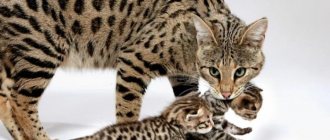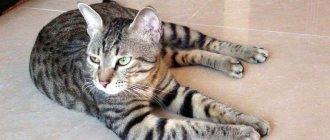Viverrid fishing cat in the wild
The civet fishing cat lives in tropical and subtropical regions of Southeast Asia, in Southeast India, Indochina, Sumatra, Ceylon, Java and Bali. Not to be confused with the jungle cat, which differs from the civet both in appearance and in its lifestyle. Fish cats settle near reservoirs, lakes, swamps and slow rivers, in general, wherever they can find food and not be seen by humans. An adult civet cat occupies a territory of 4-8 km2, the territory of males can reach 22 km2.
Fishing cats breed all year round. Pregnancy lasts 63-70 days. Litters are not numerous, usually 2-3 kittens are born. At 4.5 months, the young animals switch to adult food, and by 9 months they catch up with the size of their parents and switch to self-sufficiency. Reaches sexual maturity much later, at 2-3 years. In captivity, males help the female raise offspring; how they behave in the wild is not known for certain. And the rest of the way of life of civets has not been studied well enough.
Video about civet fishing cats:
Appearance
Externally, the civet fishing cat resembles an African civet. Actually, thanks to its Latin name - viverra, and its external resemblance, it got its name. Like wild cats, African civets are predators, but they are known for another feature - they eat coffee berries. The beans that pass through their digestive tract are collected, roasted and brewed into an expensive coffee drink called Luwak Coffee.
But let's get back to the fishermen. The weight of an adult cat is 11-15 kg, cats weigh less - 6-7 kg. The body length is 96-120 cm, and the height at the withers is 38-40 cm. The fangs of an adult cat reach 3 cm in length, the claws 1.5-2 cm. Experts divide fishing cats into two types, which differ slightly in color and size . Fishermen from Southeast Asia, including the island of Sumatra, are much larger than their relatives from the islands of Java and Bali. In the cat family, the closest relatives of fishermen are Far Eastern (Amur) cats.
The fishing cat has a strong build and well-developed muscles. In general they are very strong and agile. The muzzle is wide and short. The bridge of the nose is practically absent, the nose is very wide and large, the widest among all cats. This structure allows the cat to swim and dive freely. The ears are round, small, and set low on the sides of the head. The lower jaw is very well developed and rounded. The head fits well on the short neck. The legs are relatively short, as is the tail, which makes up 1/4 of the entire length of the body and has the same thickness from base to tip. The color is grayish-brown with black stripes and spots. Behind the pinna, which is mostly black, there are white spots called eye spots. There are webs between the toes on the front paws. They prevent the cat from fully retracting its claws, but are very helpful in swimming and fishing.
Character and behavior
In the wild, the civet fishing cat is very careful, avoids meeting people in every possible way and, if possible, will not enter into conflict, but will always be able to stand up for itself. Many people talk about their aggressiveness and assertiveness. Local residents tell many stories about fishermen who entered settlements, were not afraid of anyone and easily dispersed a pack of dogs. There is a myth in Singapore that a baby was carried away by a fish cat. However, there is no documentary evidence of this. But there is another true fact. In one zoo, a very large male escaped from his cage and ended up with a leopard, which he killed in a fight.
The civet fishing cat can meow and hiss, and also makes other interesting sounds that vaguely resemble laughter, barking, or a short abrupt yelp. They are difficult to describe, but can be heard in the video. The main occupation of the fisherman is rest and sleep; in his free time, the animal wanders through shallow water in search of food or hunts small terrestrial animals. In zoos, civet cats lead a moderately active lifestyle, they can frolic a little, but generally they do not waste energy. They can climb trees, but do not like to climb high on branches. Rookeries are built on the ground or rest at low altitudes.
Viverrid cat as a wild animal
In the wild, civet cats live near swamps and lakes, where they can get food and also be unnoticed by people. Fishing cats live in Southeast Asia and India. In addition, civet cats can be found on the following islands: Ceylon, Sumatra, Bali and Java. An adult viverrid cat has in its possession from 4 to 8 km2, and the domain of an adult male reaches 22 km2.
Cats breed - fishermen can breed all year round; the fetus is gestated from 63 to 70 days. Healthy civet females give birth to small offspring, a maximum of 3 kittens. The female raises the offspring for up to 9 months, after which they not only feed like adults, but also catch up with them in size.
Fishing cats mainly hunt for prey in shallow waters, although they can also do this in deep waters. The membranes on the paws of fishing cats give them the opportunity to swim vast distances in search of prey. In addition, during their hunt, civet cats can even dive shallowly, pressing their ears tightly, protecting them from water.
External characteristics of civet cats
In terms of external characteristics, cats are classified as large predators. The size of civet cats - fishermen - is quite impressive and respectable. An adult male reaches 15 kilograms, and a female reaches 10.
The total length of the body, together with the massive tail of an adult individual, reaches 120 cm. The tail of civet cats has a distinctive feature. The diameter of the tail of an individual is absolutely the same from base to tip. The very squat and muscular body of the cat already indicates that it is a true predator.
The muzzle of a civet cat is short and quite wide. The main distinguishing feature from other individuals of the cat family is the absence of a nasal bridge. Due to this, the nose of this breed is very wide and massive. In addition, the absence of a bridge of the nose allows anglers to hold their breath when diving into the water. Where water does not flow into the nasal cavity.
The color of these cats comes in two types: olive-gray and olive-brown. The civet cat has black spots and longitudinal stripes on its body.
The membranes on the front paws perform the main functions for their existence. They help cats during long swims, as well as when hunting fish.
What do civet cats eat?
Of course, the main dish in the diet of Asian fish cats is fish. They hunt it most often during the day in sunlight. Viverrid cats sit on the shore of a lake or shallow river and patiently wait for passing fish. If they notice one, they hit him sharply with their clawed paw.
At night, viverrid cats mainly catch other food such as snakes and birds, frogs and crustaceans. Viverrid cats are also dangerous for households at night; they can hunt domestic dogs and birds, calves and goats.
Type of character and behavior of civet cats - fishermen
Cats - fishermen, despite the fact that they are predators, do not have their inherent aggressiveness. These cats are especially careful and try not to get into people's sight. If possible and to the extent of their precautions, cats avoid any conflicts. Although if they feel a real threat, they can confidently stand up for themselves and their relatives.
There are many different stories about their aggressiveness in their habitat. Local residents recall seeing civet cats right in their settlements. Where they boldly dispersed packs of dogs. In addition, there is a story among local residents of Singapore about how a fishing cat stole a baby. But these are just stories of local residents that have no confirmation. The strength and aggressiveness of cats is evidenced by only one confirmed case. An impressive male civet kept in a zoo ran out of his cage and ended up with a leopard. The civet cat, the fisherman, easily won the fight.
The main and favorite pastime of fishing cats in their natural habitat, in their free time from hunting, is rest and sleep. In the zoo, cats are also moderately active; they can play, but they prefer not to waste their strength and energy in vain.
Keeping a fishing cat in captivity
Exotic lovers should always remember that civet cats, fed from a young age and raised with love, remain wild animals. Even if you manage to raise a relatively docile person, you need to be constantly on guard. Little kittens are very playful, quickly become attached to humans, obedient and affectionate, and very vocal. At the same time, not only the timbre of their voice is striking, but also its volume and variety of sounds. Both the kitten and the adult cat are much more energetic than their domestic counterparts.
There are many nuances in raising a civet cat. A person who has never encountered keeping wild animals is unlikely to be able to raise an adequate animal without an experienced mentor.
To gain the respect and love of an animal, it is literally hand-fed from a very young age. At the same time, they do not allow you to play with your arm or leg. There are toys for games. In the process of education and weaning from unwanted behavior, you should not shout, much less hit the cat. This usually causes a negative counter-reaction: aggression or a desire for revenge.
The civet fishing cat is an exceptionally wild predator, which finds it difficult to adapt to life in captivity, even in a zoological park, let alone in an apartment or country house. The animal needs space, its own hunting territory and pond.
The civet fishing cat reaches sexual maturity at 2-3 years. This is where the biggest problems begin. First, he begins to mark the territory. It is clear that the amount of urine and its smell are in all respects superior to those of a domestic cat. Secondly, the kitten is now becoming an adult and begins to look for its place, shows aggression, wins territory and a “place in the sun.” Castration and sterilization will not be able to completely eradicate aggression and other habits that are unacceptable for a domestic cat. One of the family members may become an object of desire, and the other, on the contrary, an enemy. It is very difficult to resist the arguments of a sexually anxious animal, which also has incredible strength and sharp claws. If you plan to keep a fishing cat as a pet, it must be castrated/sterilized no later than eight months of age.
The fascination with civet cats began in 2006, when the first articles about an angler named John Davis appeared on the Internet. The cat settled in an ordinary Krasnoyarsk apartment and even acquired a personal website on which his whole life is described with many photos. The wild predator was raised from small claws. For 3 years he lived with a family and was friends with a Siberian cat. The story ended with a sad parting and the cat moving to the zoo. The problem was that the matured fisherman began to “win” the mistress from her husband.
A civet fishing cat is not the best option for an apartment or even a private house. The optimal way to keep an exotic animal is a very spacious enclosure that imitates a natural habitat, that is, with thickets and a stocked pond.
The area is fenced on all sides with a net, including from above.
In the absence of trees, be sure to make shelves at different heights or install saw cuts. Small insulated houses will be installed in one or several places. It is especially important to maintain a positive temperature in them during the cold season. Fishing cats do not tolerate frost well.
What you should know before purchasing a fishing cat
Despite the difficulties in obtaining permission to raise civet fishing cats, the number of professional breeders opening nurseries specializing in breeding this breed of wild cats is increasing every year. Therefore, people who decide to place a fishing cat in their home should only contact a cattery to purchase one. The kitten must be no older than two months.
From the first days of life in a new home, the baby needs to be hand-fed, then he will quickly get used to both his owner and the new home. He must constantly be among people. Many owners of country houses set up an aviary on their property. If a growing fishing kitten is constantly kept in an enclosure, it will never become truly domestic.
Like an ordinary domestic cat, the fishing cat loves to play and expects affection from its owner. However, during the game he may get carried away and not calculate his strength. For damage caused (scratches or bites), he should not be scolded or beaten. The cat immediately begins to defend himself. The best punishment for him would be the word “no,” spoken in a stern voice. You can also blow in his face - cats really don’t like this.
Since in nature fishing cats live in packs, when living at home they consider all family members to be their pack, demanding attention from everyone who lives in the house.
Therefore, if the pet has done something wrong, it is better to leave it alone, locking it in the room. Civet cats are extremely smart and understand that they are offended by him.
The main problems begin when the fishing cat reaches puberty. In big cats this occurs at the age of 2-3 years. If a male lives in the house, then the first sign of maturation is the territory he has marked, which he considers his property. If the cat is not intended for breeding, it should be neutered no later than eight months of age.
One of the Russian owners of a civet fishing cat spoke in his blog about the problem due to which they were forced to give him to the zoo. The matured pet began to protect the “females” of his pack (that is, the women living in the house), from the “male” - his breadwinner. The separation became a real test for family members.
Therefore, it is better to get a cat of a regular breed. If you really want to have a huge cat in your house, then there are plenty of large-sized domestic cats.
Diet
The gastronomic preferences of fishermen are very different from those of most other cats. The basis of their diet is live fish and other aquatic inhabitants: frogs, snails.
Cats hunt in several ways. In search of food, cats can wander for a long time in shallow water or wait on the shore, then with a well-aimed jump they rush at the prey; if necessary, they swim and dive for fish. It is interesting that during hunting they often resort to cunning: they stand motionless in the water and lightly touch the surface with their whiskers. This way they imitate the movement of insects and attract fish. Cats also eat birds, small mammals, rodents and carrion. On land they sometimes hunt insects. In exceptional cases, they may attack larger animals.
What to feed a fisherman at home
A cat's diet at home should be as close to natural as possible. This refers not only to the type and quantity of food, but also to the method of obtaining it. That is, the fisherman should have the opportunity to hunt fish in a body of water, catch a live mouse or gut a bird. Naturally, there will be a lot of dirt as a result of such nutrition. A civet fishing cat can accept any animals that are smaller than it for food. The daily norm is 0.2-0.5 kg of fish or meat.
Considering that the activity and energy needs of domestic cats are much lower than in nature, a hungry or semi-starved day is arranged once or twice a week. The diet is supplemented with chicken or quail eggs and fresh grass.
Is it possible to keep a fishing cat at home?
Before you get such a pet, you need to be completely sure that you will be able to cope with its wild nature. Moreover, the size of this cat is quite impressive. Males can reach 15 kg even in the wild. And if you provide him with adequate nutrition, he can become even larger. Moreover, the mobility of such a cat will be limited due to the cramped conditions of the area. You also need to think about the fact that at the withers the height of the male can reach almost 0.5 meters.
At home
As for the animal itself, it is worth noting that it can show gentleness and even affection towards humans. But the aggression from his character will not go away, and if the cat strikes or decides to scratch, then it will not be possible to get rid of it as easily as from an ordinary cat. Therefore, it is necessary to weigh the pros and cons before getting a fishing cat.
Fact! In some countries, keeping a fish cat at home is prohibited by law.
Health and life expectancy
There is little data on the life expectancy of fishing cats in nature. In captivity they usually live for about 10 years. The maximum recorded age of a civet cat in the zoo was 12 years. Animals in captivity are vaccinated against rabies and major infectious diseases of cats. Most diseases are associated with poor diet or living conditions that vaguely resemble natural conditions.
Where to buy a fishing cat: choice of kitten and price
The civet fishing cat, like many other wild cats, is protected and listed in Appendix II of CITIES. To avoid problems, its owners will have to obtain permission to maintain it from the Federal Service for Supervision of Natural Resources. In many countries around the world, domestic exotics remain prohibited. In Russia there are laws that prohibit the illegal hunting of exotic and rare animals, as well as cruelty to animals, which can be considered their keeping in an apartment or house, in limited and far from natural conditions.
There is no document as such that prohibits keeping exotic animals in an apartment. Since 2021, GOST on keeping non-productive animals in urban environments has come into force, but it is only advisory. Assistance in obtaining documents for civets is sometimes provided by private individuals or nurseries that breed them.
Advertisements for the sale of fishing kittens are sometimes posted on the Internet, but they are rare. The price of a civet kitten usually ranges from 300,000-450,000 rubles.
It is less common to come across advertisements for the sale of a wyvern at a price of about 100,000 rubles. The higher the price, the further the code is from the actual natural habitat. In addition to the amount you will need to pay for the animal, you should remember that keeping a predator will not be cheap.
What does a fishing cat eat?
Photo: Fishing cat
Naturally, the main menu for such a cat is fish. In addition to fish, a cat can eat frogs, crustaceans, snails, crabs, snakes, all kinds of insects and rodents. He also likes to eat birds. The predator can also hunt larger animals, such as a dog, a calf, a sheep. The cat will not refuse the carrion left after the meal of large predators.
Scientists conducted studies of animal excrement and, based on analysis, found that, after all, about 75 percent of a cat’s diet is fish. An adult cat eats about one and a half kilograms of fish alone per day, not counting other food sources. During the tests, grass was also noticed in the diet; apparently, it serves as a source of vital vitamins for the cat’s body.
It has not been thoroughly studied, but there is an assumption that the animals have a nocturnal lifestyle, fishing occurs mainly at dusk. The cat has many different techniques for successful fishing. Sometimes he can simply wait for a fish, hiding on the shore near the water, then with lightning speed he rushes into the water and catches the prey on a hook or claw. Another technique is to walk in shallow water and catch small fish with powerful paws. For larger prey, the cat goes swimming and, diving deeply, gets a hefty catch.
In addition to various creatures that live in the water, striped hunters also pose a threat to waterfowl. To catch them, they dive deep in advance, swim underwater the distance to the bird itself, and from the depths grab it directly by the paws. Land hunting is also quite good for these confident and courageous food seekers. The fishing cat is not only an excellent swimmer, but also an agile tree climber, although trees attract him much less than water.
Sometimes, when things are very tight with food, cats can attack poultry and small livestock, but this situation is extremely rare; the cat avoids humans and engages in robbery and robbery only out of great need in order to survive. The only thing we can say with confidence is that hunting is in the blood of this brave and tireless predator!











